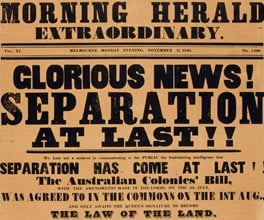Port Phillip's separation
Following the land sales boom of the late 1830s, Melbourne was the centre of a strong economy. Its inhabitants began to resent the fact that taxes from Melbourne's productivity went to Sydney, instead of funding the development of Melbourne's roads, schools and buildings.
The first Separation meeting, in May 1840, was a small affair attended by a few of Melbourne's gentry. It ended with a decision to petition the British Parliament for ‘the grant of a free Representative Government'.
At the end of the economic depression of the early 1840s, the cause gained momentum, with several public officials writing to the government in Sydney and London. They argued for legitimate representation in parliament, their own Supreme Court judge, and a proper court building instead of, as judge Redmond Barry put it, ‘being crowded into a watch-house...or the end of a store.'
In 1846, Lieutenant-Governor La Trobe wrote a comprehensive letter to the English government, outlining why decisions about Melbourne's future should be made by local representatives. A year later, it was declared that:
...all affairs of merely local concern should be left to the regulation of the local authorities.
– Earl Grey, England's Secretary of State
Cannon, M 1991, Old Melbourne town – before the gold rush, Loch Haven Books, Main Ridge, Vic.
Melbourne's goal of independence began long before the gold rush. However, separation came in 1850, around the time gold was found near Ballarat. This meant that controlling 'local concern' conveniently meant controlling the vast wealth found in the goldfields.
The Separation Bill was passed by the British Parliament on 1 August 1850, but it took 14 weeks for the news to reach Melbourne. When it did, it was simply a small notice in a South Australian newspaper, hidden between an amendment to the Dog Act and an advertisment for a virility cure, and it was almost overlooked. Fortunately, Edmund Finn – aka Garryowen – a reporter for the Herald, saw the notice and made the Herald print a special edition to make the announcement.
Extensive celebrations followed. Giant hot-air balloons carried the word ‘Separation', and a fire was lit on Flagstaff Hill, signalling the lighting of fires at five points around town, and the setting off of six rockets:
[...] it appeared as if Elizabeth and Collins Streets were rushed by a turbulent madding multitude, who tore along up and down, yelling, cheering and shouting, but doing no other harm. One half was intoxicated from drinking, and the other half quite drunk from excitement...
– Garryowen
Finn, E 1888, The Chronicles of Early Melbourne, centennial edition, 1976, Vols 1–3, Heritage Publications, Melbourne, Vic.
Garryowen's Chronicles record rare anecdotes from day-to-day life in colonial Melbourne. Newspapers are another source of colourful descriptions of people and events.
Two days later, people marched across the newly opened Princes Bridge over the Yarra to commemorate Port Phillip District's coming of age.











